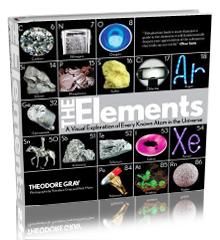Mischmetal | |||
| Sample Image | Spin Video | QuickTimeVR Rotation | |||
| Mischmetal. Rare earths are notoriously hard to separate from one another. In fact the hardest part about discovering some of them was proving that a substance thought to be a single pure element was in fact a mixture of several extremely similar ones. Since they are chemically so similar, it's not surprising that they also occur together in nature: Ores that contain one inevitably contain several of the others as well. This, combined with the difficulty of separating them, made them quite rare and unusual in pure form, until the development of modern, efficient separation techniques. But their very chemical similarity also means that in many cases it's really not necessary to separate them in the first place. If cerium will do, then so will lanthanum, or half a dozen others. A case in point is lighter "flints" which are actually made of a mixture of rare earths, primarily cerium and lanthanum, alloyed with iron. The exact ratio of rare earths in a given lighter flint isn't determined by some formula, it's determined by whatever came out of the mine that day. It would be entirely pointless to separate out and use just one in pure form: It would work, by why bother when the raw mixture works just as well? This mischmetal has not been alloyed with iron, as it would be in a flint: It's a mixture of predominantly cerium (54% cerium is a common for mischmetal), with most of the remainder being lanthanum. Others in the lanthanide series most likely contribute a few percent of the total. It's very sparky! Just shaving it with a knife produces sparks, a bit like you get when grinding iron on a grinding wheel, except you don't need the grinding wheel. (You can see that I've scraped the oxide coating off one face, a task for which I used a utility knife and file, producing great quantities of sparks in the process.) It's said that blocks like this are sometimes dragged underneath cars to produce a shower of sparks for special effects in movies or performances. It's a bit like super-sensitive magnesium. Magnesium shavings will also burn, just not spontaneously like those off this block. Blocks of magnesium are commonly sold as camp fire starters, but this stuff would work way better! In fact, to start the shavings off a magnesium fire starter, you use a flint made with this stuff. When it burns, it burns much the same way as magnesium. Metal fire is very different in appearance from wood, paper, oil, or other types of fire. One reason is that in most fires what's burning is primarily gas driven off from the solid or liquid material. Thus you get bright tongues of flame flickering above whatever is burning. But in a metal fire there is no vapor given off, so only the solid (or if it gets hot enough, liquid) metal is burning. This makes for a very compact point source of light, rather than a spread-out flame. Normal flames also tend to be yellow almost all the time, due in part to the strong yellow-orange emission line of sodium, which is present in some quantity in nearly all natural materials. Metal fires on the other hand tend to be whiter, magnesium being a particularly good example of a very, very white flame. Another difference is that the metal oxides that build up from burning metal are extremely resistant to heat (magnesium oxide is a common ingredient in high temperature insulation), and totally non-volatile (unlike the carbon dioxide that results from burning organic matter, which is a gas). Thus as metal is burning, it tends to form a crust of oxide around itself which slowly chokes off the flow of oxygen, causing the remaining metal to burn more and more slowly. (I have a story about burning magnesium which includes photographs of this lovely phenomenon.) I haven't yet set a whole block of this stuff on fire, but I've ordered a couple more and will update when I have pictures of what happens when you actually get a big chunk of it going. I'm betting that blocks of it burn a lot like blocks of magnesium, just faster. Of course I could be wrong: The added rate of reaction could blow off the oxide fast enough to avoid congestion, resulting in a much more dramatic and complete combustion. We shall see. Source: United Nuclear Contributor: Theodore Gray Acquired: 3 July, 2006 Text Updated: 4 July, 2006 Price: $45 Size: 4" Composition: CeLa | |||
|

